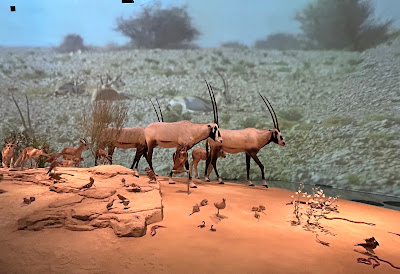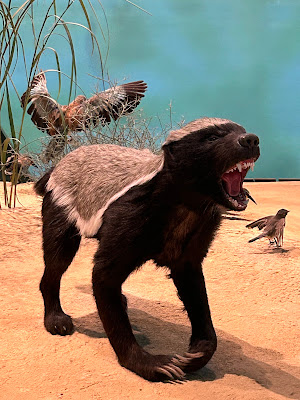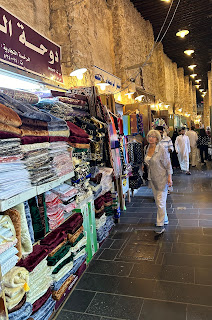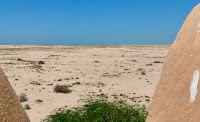Leaving Armenia, we elected for a three-day stopover in Doha, Qatar. We knew it was going to be hot there (43° in the day) but knew we could cope via air conditioned taxis, air conditioned shops, and our air conditioned hotel. The city is extremely neat and tidy with manicured gardens and roadside palms, freshly bitumised roads, sparkling glass office towers in myriad architectural styles and, I must admit, rather swish soccer stadiums built for the 2022 World Cup. I'm sure there are huge fines for anyone who dares to defile this pristine city. Oil and natural gas have been their saviour. We learnt that Qatari citizens pay no tax and contribute only about $A30 a year towards their medical expenses!
A few years back we had spent a day there and visited the Museum of Islamic Art, one of the best collections I've ever seen. We knew that a new museum had opened a while ago so were keen to visit. The National Museum of Qatar celebrates the country's culture and heritage with a fabulous display of artefacts and treasures. We spent quite a few hours there (and it wasn't just to get out of the searing heat).
The museum's design pays tribute to the desert rose crystal found in Qatar - a formation of clusters of gypsum and sand grains that form a circular array of flat plates that have been likened to a rose blossom. It was a bit too abstract for me to quite get the architect's intention, but pleasing nonetheless.
Inside, there are a number of galleries displaying three major themes: natural history; Bedouin culture; 'recent' history with the establishment of Qatar as a nation, pearling, the discovery of oil, its industries, and the nation today.
Let me take you through the galleries.
First up - natural history. I loved the way the exhibits were displayed. Behind, on the wall, were projected images that changed constantly - of the land, sea, sky.
The cultural artefacts of the Bedouins were displayed in various ways - hanging in display cases or laid out on tables, all on show in pleasing arrangements that were easy to see and inspect.
Here is a small selection.
 |
| Leather gourds for holding water. |

 |
| An array of utensils used over a fire pit. |
The textiles were amazing in their design, colour and intricacy.
Here, huge projected images on the wall showed the interior of Bedouin tents while a colourful rug was displayed in front of the ever-changing images.
Here, samples of designs line a staircase linking the galleries.
Examples of daggers and swords highlight the Bedouin's lifestyle.
We now entered a space where the entire wall was a visual delight. A huge video panorama showing a Bedouin camp, the surrounding desert, the men getting ready to go into battle, the battle itself. We sat and watched and watched. These still photos don't do the moving images justice.
 |
| They're coming to get me!!! |
And I loved this golden falcon. I asked Steve to put me in front of it for scale.

The final gallery was upon us - the 'recent' history. The importance of boats was highlighted with a number of models of fishing boats - set against a backdrop of the sea. I was lucky to capture people walking by.
Discovering oil was huge (obviously) and there was a lot of information and glass cases full of oil-related products such as telephones and vinyl records. This did not really engage me.
However, one section did...
Pearling in the 1920s was a huge industry. There were a lot of exhibits devoted to pearls, how they were collected and the simply gorgeous jewellery that was made with them.
 |
| The story of the pearl was well told. |
I was fascinated by this 'figure' of the pearler - with a peg on his nose! Check out the large weight on his foot.
Now - which one would you like to wear (or give to your favourite person)?
The end to a fascinating, educational and entertaining visit.
******************************
That evening we went to the Souk Waquif, a bustling, colourful, noisy, crowded, kaleidescopic visit indeed.
 |
| Perfume anyone? |
 |
| 'Looking for something in particular?' |
 |
| 'Lean in' said Steve - so I did, to record my purchase of a gold ring. |
 |
| A scrumptious meal. |
 |
| Quiet time for these men. |
*************************************
The following day saw us on a heritage desert tour - a trip that took us out of the city into the countryside.
First, we called in at a fishing 'village' where men were mending nets, boats were piled with nets and fishing paraphernalia and there was a hum of activity amongst the tightly packed boats.
Next stop, the nearby fish market. Not much activity because the very early morning rush from restaurants and shops was well and truly over. But it was the variety of fish that caught my eye. Lots I didn't know but I did spot the crabs!
Back in the car and we headed down the 10-lane highway that took us to the north of the Qatar Peninsula, to the historic military fort of Al Zubarah. It was built in 1938 (and after visiting fortresses in Georgia and Armenia built in the 7th century this seemed a bit tame). But in 2013 it became Qatar's first World Heritage site. It's on the north-western coast with the Persian Gulf in the distance. Originally built as a coastal guard station next to a thriving pearl fishing and trading post, its role changed over the years when the pearling industry declined then vanished due to the depression and the introduction of cultured pearls. The fort today is a museum.
It's been restored and to my mind overly so. Far too pristine and neat, depriving it of any real atmosphere. What do you reckon? At least the restoration using traditional building techniques has preserved the stonework.
We walked around the rooftop and up into the tower.
And saw the desert spread before us -
not the usual desert image of rolling golden-red sand dunes, but a stony, dry and flat landscape.The interior, while neat as a pin, had some interesting aspects.
 |
| I'm not climbing up here! |
And a fabulously thick wooden door.

Some of the rooms were devoted to its history especially pearl fishing. And objects found in the nearby archeological dig.


The diggings at nearby Ruwayda have uncovered walls, streets, houses, storerooms and a variety of artefacts when the area was an important pearl diving and trading centre. A boardwalk aids tourists to easily inspect the site. Ruins of many small villages line the shores, awaiting further exploration. We strolled through one such village (Al Jumail). In the 18th and 19th centuries it was a prosperous merchant and fishermen's town. As we wandered I couldn't help but imagine everyday life there - men setting sail in their pearling boats early in the morning to dive further out in the Persian Gulf, bringing home their prized bounty, mending nets, shopkeepers at work, merchants arriving to sell their goods, women tending the houses, the people praying in the mosque. The town's demise began, along with all the other coastal villages, when the depression took hold in the 1930s, followed soon after by a major threat to the pearling industry - cultured pearls. The village was abandoned as people moved to Doha, and a once-thriving industry was lost. All that is left today are the town's ghostly (and rather sad) remains of lives once lived.


The remains of a mosque can be seen in the distance in this next photo.
You can see how close they built to the shore.
But what a view. I'm not sure that the beauty of the view was on their minds though.
On the way back we stopped for a coffee at a restored 1950s police station. This time, the view was for 21st century tourists.
A fitting end to our Doha adventure.
**********************************






































































